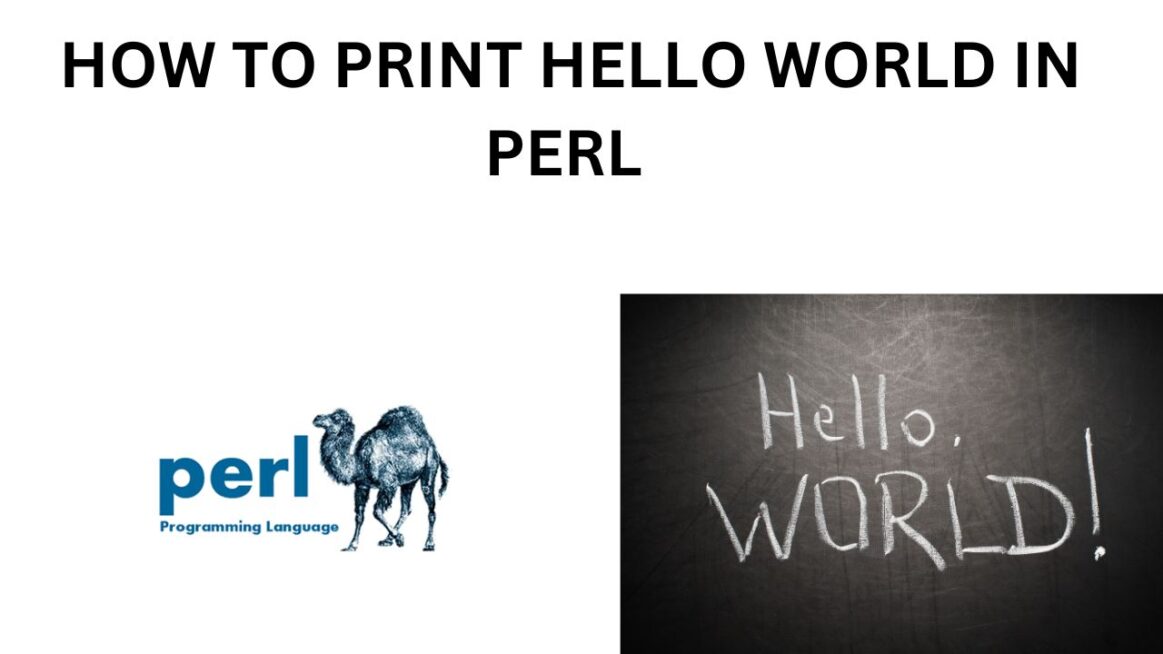Introduction to Perl Programming: Hello World Example
Perl is a high-level, versatile programming language known for its text manipulation capabilities. One of the best ways to start learning a new language is by writing a simple program that prints “Hello, World!”. This classic example helps you understand the basic syntax and structure of the language.
In this guide, we’ll walk through a simple Perl program to print “Hello, World!” along with an explanation of how it works.

The Perl Program: Hello World
Here’s a very simple Perl program that prints “Hello, World!” to the screen:
#!/usr/bin/perl
print "Hello, World!\n";
Explanation of the Program
#!/usr/bin/perl
This line is called a shebang or hashbang. It tells the system where to find the Perl interpreter. This line is important when running Perl scripts on UNIX or Linux systems, but it’s optional for Windows users.print "Hello, World!\n";
Theprintfunction outputs text to the screen. In this case, it prints “Hello, World!”. The\nat the end of the string is a special character that tells the program to move to the next line after printing the text. Without it, the cursor would stay on the same line.
Output of the Program
When you run this Perl script, the output will simply be:
Hello, World!
How to Run the Program
If you’re using a UNIX or Linux system, you may need to give the file execute permissions using this command:
Save the code in a file with a .pl extension, like hello_world.pl.
chmod +x hello_world.pl
Run The Script By Typing
./hello_world.pl
If you’re on Windows, you can run the script by typing this in your command prompt:
perl hello_world.pl
Conclusion
This “Hello, World!” example is a simple introduction to Perl, demonstrating the basic structure and syntax of a Perl program. Once you understand how to print basic text, you can move on to more complex tasks like working with variables, loops, and user input. Perl is a powerful and flexible language, and mastering its basics will help you explore its vast capabilities.
Here are some great websites where you can learn Perl programming, along with their key features and hyperlinks:
1. Perl.org
- Features:
- Official website for Perl programming.
- Offers resources for beginners, including installation guides and documentation.
- Links to Perl community resources and learning materials.
2. Learn Perl the Hard Way
- Features:
- Free and beginner-friendly guide.
- Step-by-step tutorials to get started with Perl.
- Hands-on practice exercises.
- Suitable for both beginners and intermediate learners.
3. Modern Perl
- Features:
- Free online book to learn modern Perl programming techniques.
- Focus on Perl best practices and up-to-date Perl methods.
- Emphasizes maintainability and real-world applications.
4. PerlMonks
- Features:
- A community-driven forum for Perl programmers.
- Get help with your Perl questions from experienced developers.
- Share and discuss Perl code snippets, tutorials, and projects.
5. GeeksforGeeks – Perl Programming
- Features:
- Extensive tutorials with detailed explanations.
- Includes examples, interview questions, and coding challenges.
- Suitable for beginners and professionals alike.
6. TutorialsPoint – Perl Tutorial
- Features:
- Comprehensive guide covering everything from Perl basics to advanced topics.
- Interactive examples and exercises.
- Includes Perl interview questions and a reference guide.
7. Codecademy – Perl (Paid)
- Features:
- Interactive coding platform.
- Hands-on lessons with real-time feedback.
- Suitable for beginners looking to learn by doing.
8. Udemy – Perl Courses (Paid)
- Features:
- Wide variety of Perl courses, ranging from beginner to advanced levels.
- Courses often include video lectures, quizzes, and hands-on coding projects.
- Learn at your own pace with lifetime access to purchased courses.
9. Coursera – Perl for Beginners (Paid)
- Features:
- Offers courses from universities and institutions.
- Learn Perl basics, data structures, and regular expressions.
- Provides certification upon course completion.
10. W3Schools – Perl Tutorial
- Features:
- Simple and easy-to-follow tutorials for beginners.
- Covers the essentials of Perl programming.
- Interactive code editor for testing your Perl scripts directly in the browser.
These platforms offer a variety of learning styles, from interactive tutorials to community forums, giving you flexibility in how you want to learn Perl.

